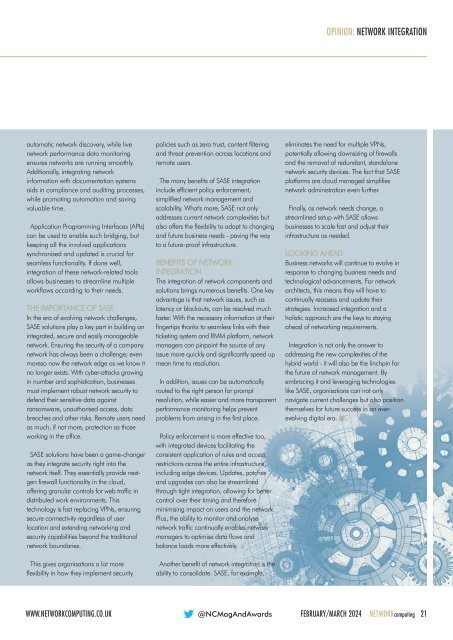NC Feb-Mar 2024
You also want an ePaper? Increase the reach of your titles
YUMPU automatically turns print PDFs into web optimized ePapers that Google loves.
OPINION: NETWORK INTEGRATION<br />
automatic network discovery, while live<br />
network performance data monitoring<br />
ensures networks are running smoothly.<br />
Additionally, integrating network<br />
information with documentation systems<br />
aids in compliance and auditing processes,<br />
while promoting automation and saving<br />
valuable time.<br />
Application Programming Interfaces (APIs)<br />
can be used to enable such bridging, but<br />
keeping all the involved applications<br />
synchronised and updated is crucial for<br />
seamless functionality. If done well,<br />
integration of these network-related tools<br />
allows businesses to streamline multiple<br />
workflows according to their needs.<br />
THE IMPORTA<strong>NC</strong>E OF SASE<br />
In the era of evolving network challenges,<br />
SASE solutions play a key part in building an<br />
integrated, secure and easily manageable<br />
network. Ensuring the security of a company<br />
network has always been a challenge; even<br />
moreso now the network edge as we know it<br />
no longer exists. With cyber-attacks growing<br />
in number and sophistication, businesses<br />
must implement robust network security to<br />
defend their sensitive data against<br />
ransomware, unauthorised access, data<br />
breaches and other risks. Remote users need<br />
as much, if not more, protection as those<br />
working in the office.<br />
SASE solutions have been a game-changer<br />
as they integrate security right into the<br />
network itself. They essentially provide nextgen<br />
firewall functionality in the cloud,<br />
offering granular controls for web traffic in<br />
distributed work environments. This<br />
technology is fast replacing VPNs, ensuring<br />
secure connectivity regardless of user<br />
location and extending networking and<br />
security capabilities beyond the traditional<br />
network boundaries.<br />
This gives organisations a lot more<br />
flexibility in how they implement security<br />
policies such as zero trust, content filtering<br />
and threat prevention across locations and<br />
remote users.<br />
The many benefits of SASE integration<br />
include efficient policy enforcement,<br />
simplified network management and<br />
scalability. What's more, SASE not only<br />
addresses current network complexities but<br />
also offers the flexibility to adapt to changing<br />
and future business needs - paving the way<br />
to a future-proof infrastructure.<br />
BENEFITS OF NETWORK<br />
INTEGRATION<br />
The integration of network components and<br />
solutions brings numerous benefits. One key<br />
advantage is that network issues, such as<br />
latency or blackouts, can be resolved much<br />
faster. With the necessary information at their<br />
fingertips thanks to seamless links with their<br />
ticketing system and RMM platform, network<br />
managers can pinpoint the source of any<br />
issue more quickly and significantly speed up<br />
mean time to resolution.<br />
In addition, issues can be automatically<br />
routed to the right person for prompt<br />
resolution, while easier and more transparent<br />
performance monitoring helps prevent<br />
problems from arising in the first place.<br />
Policy enforcement is more effective too,<br />
with integrated devices facilitating the<br />
consistent application of rules and access<br />
restrictions across the entire infrastructure,<br />
including edge devices. Updates, patches<br />
and upgrades can also be streamlined<br />
through tight integration, allowing for better<br />
control over their timing and therefore<br />
minimising impact on users and the network.<br />
Plus, the ability to monitor and analyse<br />
network traffic continually enables network<br />
managers to optimise data flows and<br />
balance loads more effectively.<br />
Another benefit of network integration is the<br />
ability to consolidate. SASE, for example,<br />
eliminates the need for multiple VPNs,<br />
potentially allowing downsizing of firewalls<br />
and the removal of redundant, standalone<br />
network security devices. The fact that SASE<br />
platforms are cloud managed simplifies<br />
network administration even further.<br />
Finally, as network needs change, a<br />
streamlined setup with SASE allows<br />
businesses to scale fast and adjust their<br />
infrastructure as needed.<br />
LOOKING AHEAD<br />
Business networks will continue to evolve in<br />
response to changing business needs and<br />
technological advancements. For network<br />
architects, this means they will have to<br />
continually reassess and update their<br />
strategies. Increased integration and a<br />
holistic approach are the keys to staying<br />
ahead of networking requirements.<br />
Integration is not only the answer to<br />
addressing the new complexities of the<br />
hybrid world - it will also be the linchpin for<br />
the future of network management. By<br />
embracing it and leveraging technologies<br />
like SASE, organisations can not only<br />
navigate current challenges but also position<br />
themselves for future success in an everevolving<br />
digital era. <strong>NC</strong><br />
WWW.NETWORKCOMPUTING.CO.UK @<strong>NC</strong>MagAndAwards FEBRUARY/MARCH <strong>2024</strong> NETWORKcomputing 21
















